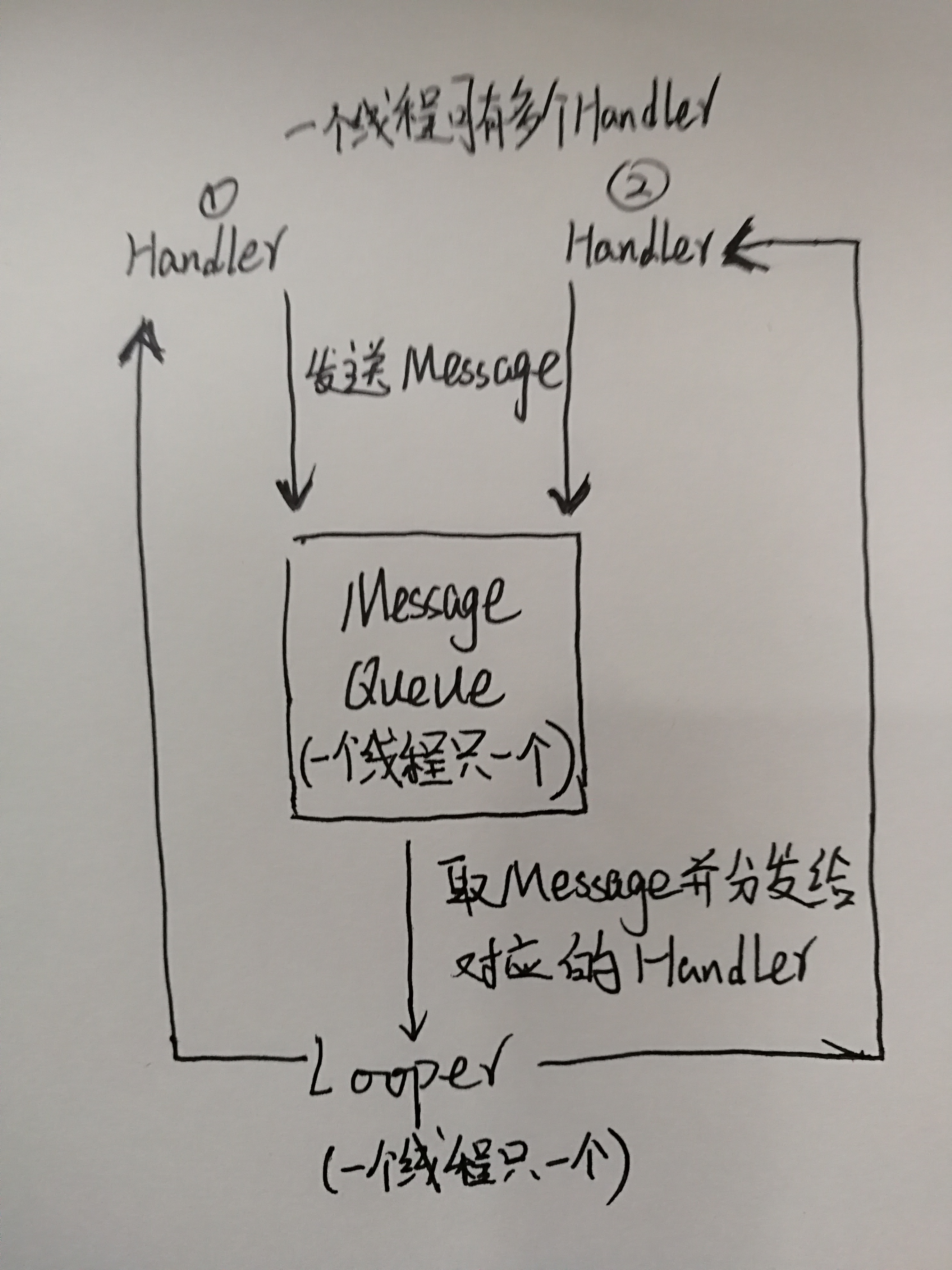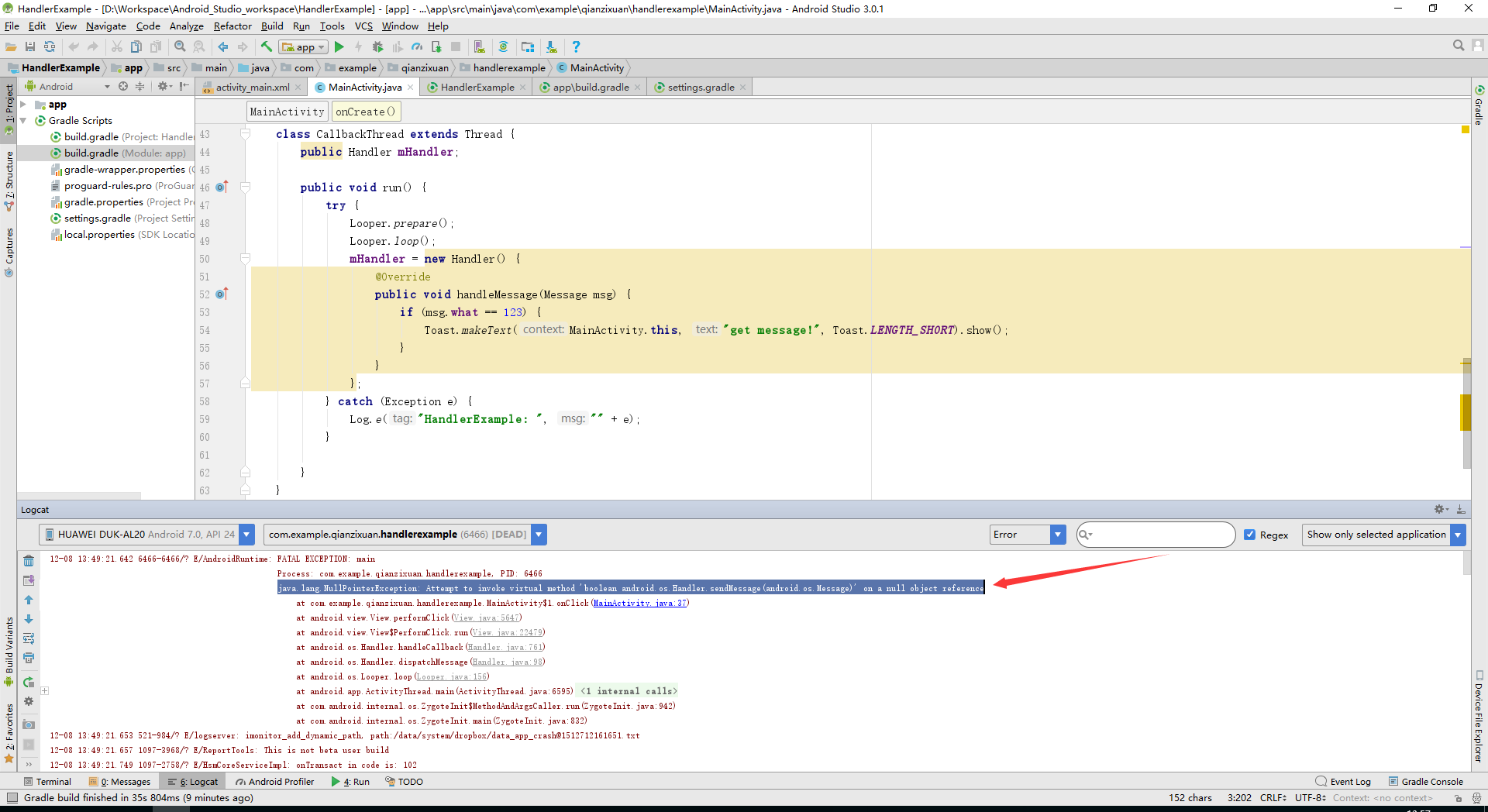内容摘要:Android Handler消息传递机制的学习总结、问题记录
Handler消息传递机制的目的:
1.实现线程间通信(如:Android平台只允许主线程(UI线程)修改Activity里的UI组件,而实际开发时会遇到新开的线程要改变界面组件属性的情况,这时就要有一种办法通知主线程更新UI)。Handler消息传递机制可用于线程间传递消息。
2.实现消息的异步处理。
机制的实现:(工作原理涉及Handler、Looper、Message(消息)、MessageQueue(消息队列);代码分消息接收方,发送方2处)
原理说明(本人理解有限,比较好的Handler说明看这篇):
Handler可发送Message到MessageQueue或处理从Looper收到的Message。
Message消息对象,在整个机制中传递。
MessageQueue是一个以先进先出方式管理Message的队列。
Looper管理MessageQueue,它把从MessageQueue里取到的Message分发给相应的Handler。
原理图:

注意:
1.Handler是建立在Looper上,实现Thread的消息系统处理模型,实现消息异步处理的;
2.MessageQueue会在Looper(Looper()构造函数)初始化时创建关联;
3.一个线程最多只能有一个Looper对象(Looper.prepare()方法创建Looper对象,规定了这个);
4.主线程(UI线程)系统已经帮初始化了一个Looper对象(简单分析看这,主线程源码详细分析看这),因此程序直接创建Handler即可;程序员自己启动的线程必须先创建Looper对象并启动(调用Looper.loop()),然后才能向该线程的消息队列发消息。
Looper源码参考:
prepare()方法保证每个线程最多只有一个Looper对象,loop()方法使用一个死循环不断取出MessageQueue中的消息,并把取出的消息分给对应的Handler处理。
1 //Looper初始化时创建并关联MessageQueue 2 private Looper(boolean quitAllowed) { 3 mQueue = new MessageQueue(quitAllowed); 4 mThread = Thread.currentThread(); 5 }
1 //一个线程最多一个Looper,调用prepare()方法创建Looper对象 2 public static void prepare() { 3 prepare(true); 4 } 5 6 private static void prepare(boolean quitAllowed) { 7 if (sThreadLocal.get() != null) { 8 throw new RuntimeException("Only one Looper may be created per thread"); 9 } 10 sThreadLocal.set(new Looper(quitAllowed)); 11 }
1 /** 2 * Initialize the current thread as a looper, marking it as an 3 * application's main looper. The main looper for your application 4 * is created by the Android environment, so you should never need 5 * to call this function yourself. See also: {@link #prepare()} 6 */ 7 //主UI线程初始化Looper对象调用的方法 8 public static void prepareMainLooper() { 9 prepare(false); 10 synchronized (Looper.class) { 11 if (sMainLooper != null) { 12 throw new IllegalStateException("The main Looper has already been prepared."); 13 } 14 sMainLooper = myLooper(); 15 } 16 }
1 /** 2 * Run the message queue in this thread. Be sure to call 3 * {@link #quit()} to end the loop. 4 */ 5 public static void loop() { 6 final Looper me = myLooper(); 7 if (me == null) { 8 throw new RuntimeException("No Looper; Looper.prepare() wasn't called on this thread."); 9 } 10 final MessageQueue queue = me.mQueue; 11 12 // Make sure the identity of this thread is that of the local process, 13 // and keep track of what that identity token actually is. 14 Binder.clearCallingIdentity(); 15 final long ident = Binder.clearCallingIdentity(); 16 17 //使用一个死循环不断从MessageQueue取Message,并发给对应Handler 18 for (;;) { 19 Message msg = queue.next(); // might block 20 if (msg == null) { 21 // No message indicates that the message queue is quitting. 22 return; 23 } 24 25 // This must be in a local variable, in case a UI event sets the logger 26 final Printer logging = me.mLogging; 27 if (logging != null) { 28 logging.println(">>>>> Dispatching to " + msg.target + " " + 29 msg.callback + ": " + msg.what); 30 } 31 32 final long slowDispatchThresholdMs = me.mSlowDispatchThresholdMs; 33 34 final long traceTag = me.mTraceTag; 35 if (traceTag != 0 && Trace.isTagEnabled(traceTag)) { 36 Trace.traceBegin(traceTag, msg.target.getTraceName(msg)); 37 } 38 final long start = (slowDispatchThresholdMs == 0) ? 0 : SystemClock.uptimeMillis(); 39 final long end; 40 try { 41 msg.target.dispatchMessage(msg); 42 end = (slowDispatchThresholdMs == 0) ? 0 : SystemClock.uptimeMillis(); 43 } finally { 44 if (traceTag != 0) { 45 Trace.traceEnd(traceTag); 46 } 47 } 48 if (slowDispatchThresholdMs > 0) { 49 final long time = end - start; 50 if (time > slowDispatchThresholdMs) { 51 Slog.w(TAG, "Dispatch took " + time + "ms on " 52 + Thread.currentThread().getName() + ", h=" + 53 msg.target + " cb=" + msg.callback + " msg=" + msg.what); 54 } 55 } 56 57 if (logging != null) { 58 logging.println("<<<<< Finished to " + msg.target + " " + msg.callback); 59 } 60 61 // Make sure that during the course of dispatching the 62 // identity of the thread wasn't corrupted. 63 final long newIdent = Binder.clearCallingIdentity(); 64 if (ident != newIdent) { 65 Log.wtf(TAG, "Thread identity changed from 0x" 66 + Long.toHexString(ident) + " to 0x" 67 + Long.toHexString(newIdent) + " while dispatching to " 68 + msg.target.getClass().getName() + " " 69 + msg.callback + " what=" + msg.what); 70 } 71 72 msg.recycleUnchecked(); 73 } 74 }
原理总结到这,下面看看在代码中具体如何实现
代码示例(只是一种实现,更多Handler用法总结看这):
1.消息接收方线程先调用Looper.prepare()创建Looper对象,然后创建Handler对象并定义处理消息的方法,接下来调用Looper.loop()启动Looper。
1 class CallbackThread extends Thread { 2 public Handler mHandler; 3 4 public void run() { 5 Looper.prepare(); 6 mHandler = new Handler() { 7 @Override 8 public void handleMessage(Message msg) { 9 if (msg.what == 123) { 10 Toast.makeText(MainActivity.this, "get message!", Toast.LENGTH_SHORT).show(); 11 } 12 } 13 }; 14 Looper.loop(); 15 } 16 }
2.消息发送方线程通过调用Handler类相关方法向接收方线程的Handler对象发送消息,可用的方法有:

1 callbackThread = new CallbackThread(); 2 callbackThread.start(); 3 4 //发空消息 5 callbackThread.mHandler.sendEmptyMessage(123); 6 7 //创建消息发送 8 Message msg = new Message(); 9 msg.what = 123; 10 callbackThread.mHandler.sendMessage(msg);
以上是Handler学习总结,接下来是学习过程中遇到的问题记录。
问题记录
1.代码示例中接收消息的线程是先调用Looper.prepare(),再创建Handler实现消息处理方法,最后再Looper.loop()。为什么是prepare->Handler->loop这个顺序?可不可以换?
答:顺序不能换。首先prepare是肯定要在loop之前,因为prepare()方法源码注释中有这样一句话(Be sure to call* {@link #loop()} after calling this method),那就按它的来(因为我没看源码......)。可还有两种顺序是吧,一个个试下。Handler->prepare->loop不行,现象是发出的消息没被接收。prepare->loop->Handler也不可以,现象是导致APP退出。我(zhao)的(chao)理(wang)解(shang)是Handler要想正常工作首先要保证当前线程中有Looper对象(why?可能是能发消息首先要有消息队列?),所以先要prepare创建Looper对象;然后Looper.loop()使用死循环取消息,且当没有消息时会阻塞,这样的话放在它之后的代码——创建Handler的代码不会执行,当调用该Handler对象的sendMessage()一类方法时便会产生NullPointerException,如下(AV画质):

2.不是说只有UI线程能对UI组件操作,为什么当上面截图中代码把创建Handler对象放在prepare和loop之间时,子线程使用Toast不报错还能显示?
答:首先子线程直接用Toast是不行的,不会弹出Toast只会报错......之后我上网找啊找啊找到这篇,只是后面得出结论的时候说“Toast可能是属于修改UI界面”???这几个意思???于是我又找啊找啊,知乎找到这个问题,天啊!用了Toast这么久难道它不是更新UI操作,可能正如知乎上大佬说的——“吐司操作的是window,不属于checkThread抛主线程不能更新UI异常的管理范畴”?信息量太大,我能力有限还没理解,先存疑记录//Todo。总之,现在知道Toast要在子线程中使用可以借助Looper。
3.Looper.loop()使用死循环取消息难道不会很耗资源吗?
答:并不会,具体看这篇。简而言之,死循环中调用queue.next()读取下一条消息(在loop调用的线程中),如果读取到了就msg.target.dispatchMessage(),否则queue.next()则会一直阻塞到超过超时时间。
4.主线程Looper也调用了loop(),会不会也阻塞?
答:也会有阻塞,但不会卡死,其实和问题3是一个道理,MessageQueue没消息了都会阻塞进入休眠,之后会被句柄写操作唤醒epoll.wait。参考:知乎问题,CSDN文章(虽然文章标题和结论矛盾)。
5.queue.next()的阻塞是怎么实现的?
答:参考3,4中的链接。关键字:Linux pipe/epoll机制,loop()的queue.next()中的nativePollOnce()方法。
感想:第一篇博客花了我一晚上一早上加半个下午,妈呀!那些大佬都怎么这么高产的。问题其实还有更多的,但一部分忘了记录下来,一部分太不成熟,再就是还存在没发现的问题......越来越懵逼了,完全没有豁然开朗的感觉???主要是知道的太少了,一次性见识到这么多新的事物消化不来,学习笔记也很乱,毕竟第一次写博客,慢慢学吧,Android之路长着呢,嘻嘻嘻!